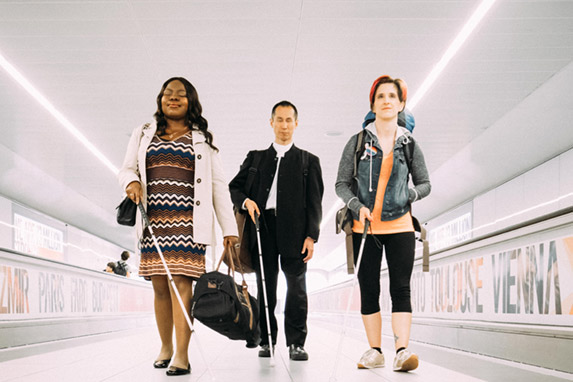
Victoria Oruari, Takashi Kakuchi and Amelia Cavallow walk between travelators at an airport. Photo by Christopher Andreou.
I was awarded an ASEF Cultural Mobility grant this summer and In October I visited Japan for the first time. I am now beginning production on a new touring show called Flight Paths in collaboration with Yellow Earth, the UK’s leading South East Asian theatre company. Together the artistic Director Kumiko Mendel of Yellow Earth and I will co-direct this multi media production inspired by the Japanese tradition of Biwa Hoshi and the Goze women who were blind historic story-tellers and musicians travelling Japan earning their living. Flight Paths will similarly tell the story of contemporary blind artists who have travelled from their homelands of four continents to forge their careers in the UK.
http://extant.org.uk/flightpaths/
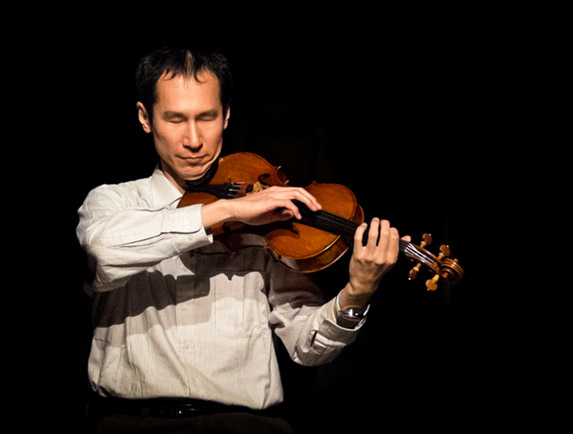
Takashi Kakuchi plays viola. Photo by Hajime Kato.
As the show has a strong Japanese theme that features a blind Japanese artist, Takashi Kakuchi, I wanted to have an opportunity to visit Japan ahead of the production that went into rehearsals in November. This was to help me connect more with Japanese culture before taking on the challenge of directing the production and also to make stronger contacts with disability arts organisations which Kumiko had visited the year before in Japan and introduced them to my work.
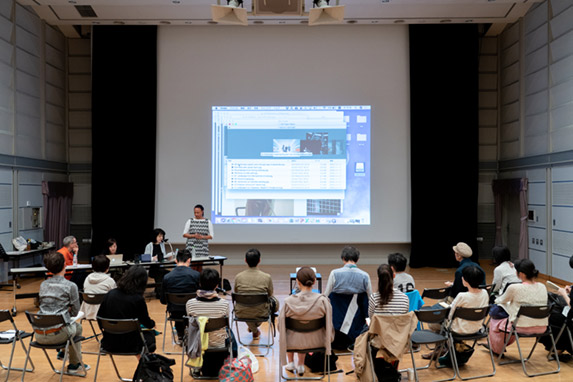
Maria presents in front of a screen to an audience. Photo by Hajime Kato.
So during my trip I gave a lecture and ran a workshop for some associated artists of Slow Label in Yokohama
They ranged from circus, dance and visual artists to musicians, and all had an interest in disability art, galvanised by the Director of Slow Label Kris Hoshi, who is also advisor to the opening ceremony of the Tokyo 2020 Paralympics.
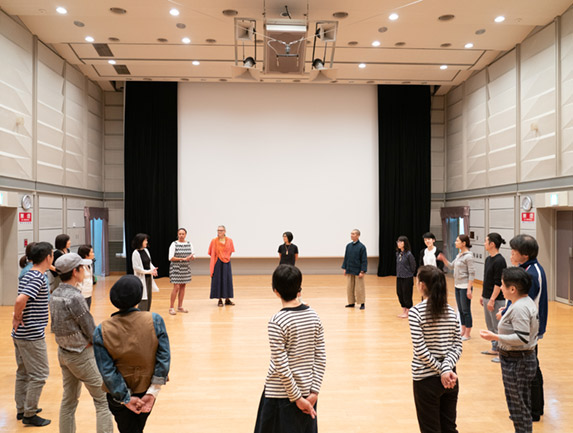
Artists standing a circle with Maria. Photo by Hajime Kato.
As well as officers from Yokohama city council, Yoko Ijichi attended who runs the Muse Company that has previously brought disability arts from the UK to Japan such as Wolfgang Stange of Amici integrated dance company and Choreographers from Candoco.
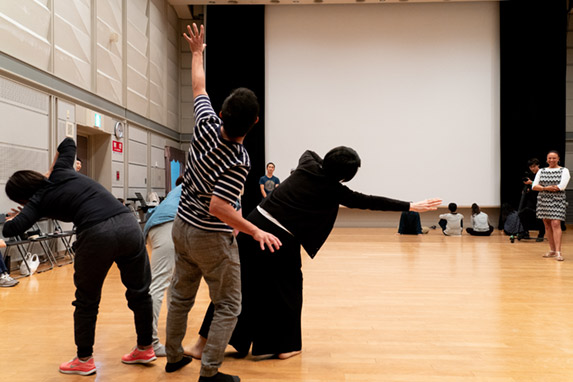
Maria observes while group participate in an exercise. Photo by Hajime Kato.
Slow Label will be presenting the film of my lecture and workshop at their Paratriennale Festival in Yokohama in February 2019 and considering with arts officers at Yokohama City Council (twinned with England for 2020) how Flight Paths might feature in their programming.
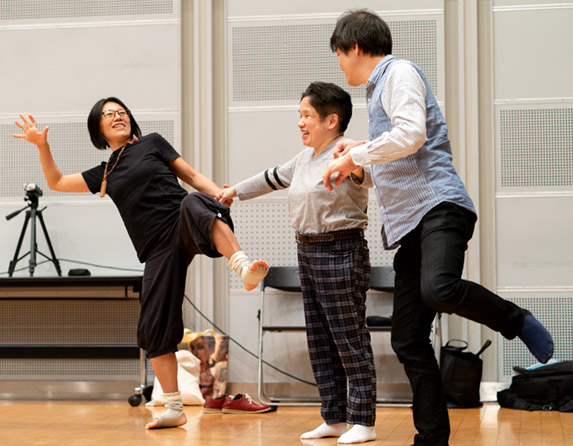
Group participate in a balance exercise. Photo by Hajime Kato.
I also met with Chika Sudo at the British Council office and Mariko Mori Director of Diversity in the Arts at the Nippon Foundation and her assistant director Mei Harada at their Tokyo office.
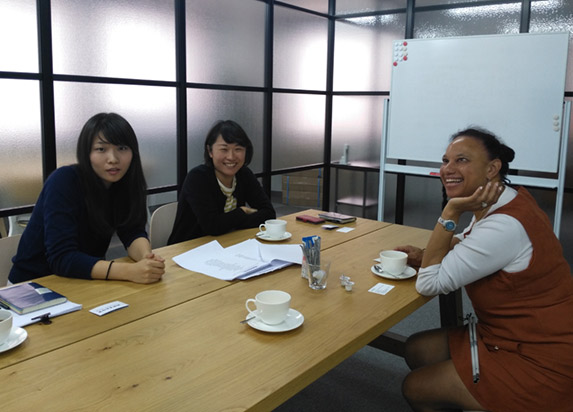
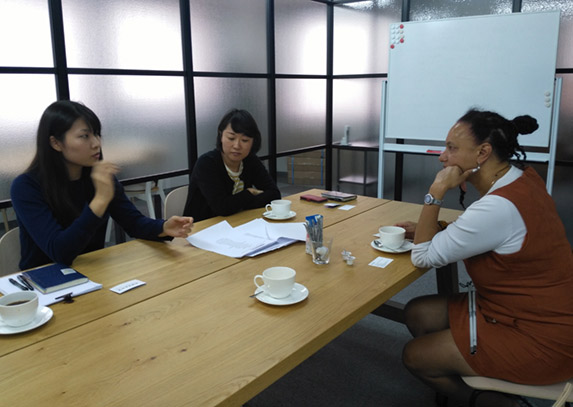
Maria sits at a table in discussion and smiling with Mariko Mori and Mei Harada at The Nippon Foundation.
I also gave a presentation for Eiko Sasaki who runs an applied theatre cafe in Tokyo.
https://appliedtheatre.wixsite.com/labo/blank-2
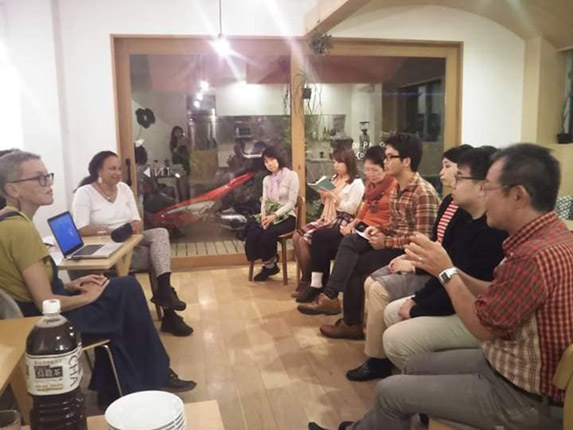

Maria sits at a table talking to the group and is gathered with them for a group photo
This was an interesting and thoughtful gathering of Japanese psychiatrists, educationalists and arts practitioners, keen on bringing new perspectives to their work – Here is some feedback I received after the presentation:
• Thank you very much for your gracious lecture using example photos. I was pleased to listen to your exciting talk!
• I felt your works are very artistic seeing the videos. I was also empowered by what you have been challenging a lot of new works.
• Thank you for sharing what you are doing. It was interesting & great experience for me.
• I was impressed and felt that extending possibilities become bigger power mixing various people.
• I was surprised that your experimental and challenging way to create works totally did not make us feel no barrier at all.
• I am very impressed and excited !!

Kabuki dancers performing on an outdoor stage
Over dinner with Miyuki Tanaka, an independent producer and developer of audio description, I learnt that the role of the contemporary artist in Japan is very marginal, with design being much more highly valued. I gained an understanding that to be an ‘artist’ very much meant doing this as a hobby or along-side another job that could bring in an income. Unless it was the kind of art that was highly commercial, which within Japanese culture is very much influenced by the US market. This chimed with the fact that I learnt that the equivalent of the Arts Council has only just been set up in Japan within the last two years in response to the lead up to 2020.
In comparison England has a rich appreciation and support of the arts, both commercial and subsidised which is perceived as culturally valuable for its own self expressive, training, engagement, educational and artistic reasons. Though both countries are driven by capitalist market forces, there seems much more emphasis on this in Japan with design and productivity being prized.
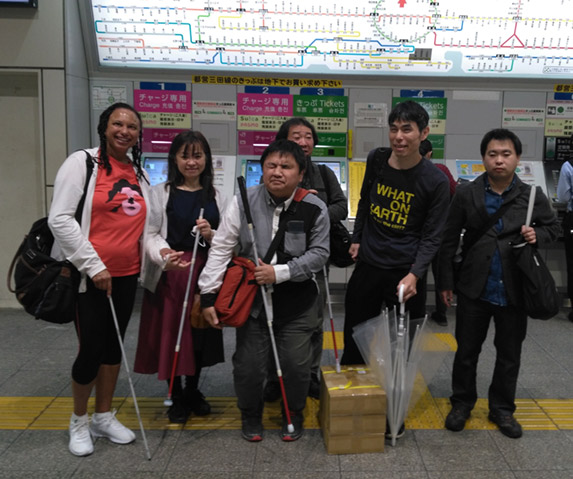
Maria with group of visually impaired tennis players all standing in front of a large Tokyo subway map
I was aware of quite a few disabled people while I moved around Tokyo but learnt that it is very different outside of the city centres for disabled people, who very much stay within the home and within institutions.
Therefore I feel Japan has a long way to go in developing the artistic and organisational leadership of disabled artists but the organisations, groups and individuals I met are enabling this journey to start.
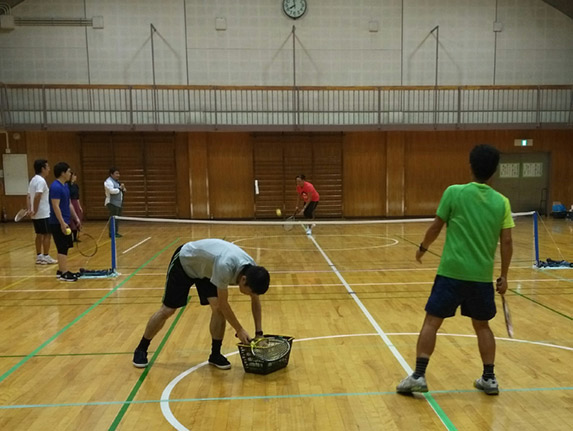
The Japanese tennis coach serves a sound ball to Maria
One highlight of my trip was making contact with the co-ordinator of the blind tennis game Sound Ball which was invented in Japan by a blind student called Miyoshi Takei in the 1980’s. Since then the game has grown and developed in many countries all over the world and is very popular in the UK. I wanted to meet some visually impaired people outside of the arts sector and take part in one of their sessions. I enjoyed meeting and talking with these Japanese visually impaired people who welcomed me generously. Having experienced the intensity of the Tokyo subway during my visit, it was unsurprising but tragic to learn of the death of Miyoshi Takei a few years before on the subway system. As it was his dream to introduce Sound Ball into the Paralympics I have suggested that Slow Label get to tell his story in some way during 2020.
Personally I picked up certain aesthetics and feelings during my trip which will help me in directing Flight Paths with Kumiko. We have something of a shared experience now going into this process together, her being half Japanese and more familiar with the country. My trip has deepened my understanding of the experience of blind people in Japan which increases the connection with Mr Kojiro Hirose, a blind anthropologist from Osaka who we brought to London in September to share his knowledge of the culture of Biwa Hoshi and Goze.
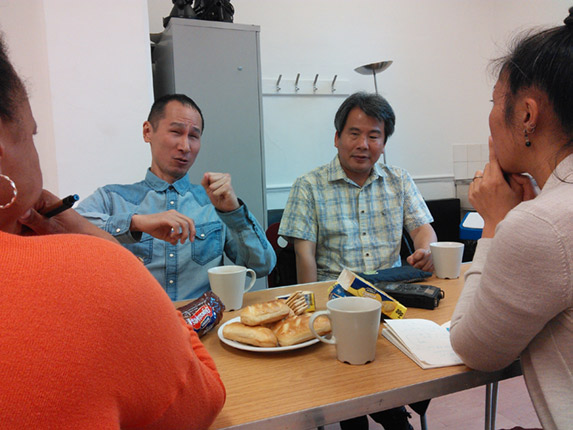
Professor Hirose and Takashi in dialogue at a table
This trip was a wonderful experience, to have the opportunity as a blind theatre practitioner, to share knowledge of creating years of professional performance by visually impaired artists in the UK with organizations in Japan so enthusiastic to learn about artistic access for disabled artists and audiences. Also to have the opportunity to begin to learn something of a culture and country I knew so little about.